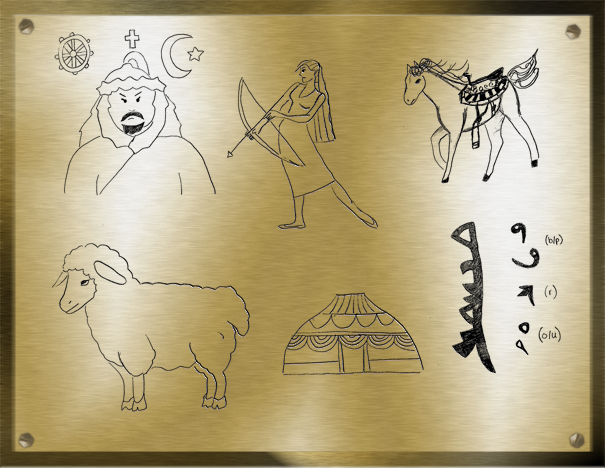| Time Period | Genghis Khan’s Rule over the Mongols (1203-1227 C.E.) |
| Geographical Region | Starting from the Mongolian area and spreading south throughout China and west towards the Caspian Sea |
| List of Symbols |
|
The Mongol man is a representation of Genghis Khan. The Mongolian horse behind him represents how important horses are to the Mongols. The physical structure of these horses (short) allowed them maneuver a lot faster than the tall European horses; the characteristics of the Mongolian horses helped the Mongols win wars. The yurts and animals represent the nomadic life style of the Mongols; they followed their animals year round and created yurts as a temporary home before moving to a different area. The four Black Tug banners represent Genghis Khan’s army because the soldiers would carry these banners through battles. The three shapes located above the four tug banners represent the divisional units of Genghis Khan’s army. The religious symbols represent some of the different religions of the territories that Genghis Khan conquered in his lifetime.
Genghis Khan symbolizes the unification of the Mongol tribes and the start of my chosen time period. He is also the epitome of a typical Mongolian man. Being a warrior is important in Mongol life and the two weapons that Genghis Khan is carrying; a sword and bow and arrows represent the warrior idea. Mongol tribes are constantly at war in order to keep the alliances Mongol khans make with Mongol soldiers since Mongol men only pledge allegiance to a khan during wartime. The multiple weapons he is carrying also represent how well rounded Mongols were at war. They learned new techniques and used different weapons in order to make themselves better warriors during war.
Another weapon that the Mongols had on their side was their horses. Mongolian horses were a large contribution to why Mongols were such great warriors. Mongols spend a large portion of their lives on horseback because horses were their chosen mode of transportation. This made them skilled horseback riders, which gave them an advantage in wars against regions where the soldiers were not as great on horseback, like the soldiers of the Song Dynasty. Mongolian horses are also short which allows them to move faster. Their speed allowed them to turn around and run faster which is helpful in war. In war and while travelling, it was common for a Mongolian soldier to have several horses, so that the soldier could switch between riding one horse to another horse without tiring the horses out.
During this time, Mongols were living a nomadic lifestyle. They were constantly moving from area to area depending on where their animals fed. This lifestyle made it almost impossible to create stable houses, so the Mongols created yurts as makeshift houses that they would put up and take down whenever they stopped in a new area to rest. The goats and sheep also provided two key sources of food for the Mongols: milk and cheese.
The four Black Tug banners represent war because of the black horse hair used to make them. White horse hair would represent peace. The Mongol soldiers would carry these black tug banners throughout battles and I thought this would be a good way to represent Genghis Khan’s army.
His army is called a Tumen (ten thousand men) which was built from multiple units of 10, 100, or 1000 soldiers. He was able to get these soldiers for his army from merging Mongol men from other tribes under his rule in 1203 C.E. He united the different nomadic tribes by breaking the allegiances that the men had with their khans and had them create new allegiances with him. Each of the three circle shapes represent the different numerical units of the army. A single circle represents a unit of 10 soldiers. 2 linked circles (2 overlapping circles) represent a 100 soldier unit. Each time a circle gets linked; it multiples the unit by 10, so two linked circles will be 10×10=100. The 3 linked circles represent a 1,000 soldier unit because it is 10x10x10=1000.
The religious symbols represent the different territories that the Mongols conquered under Genghis Khan. Genghis Khan expanded the original Mongol territory by invading and controlling Central Asia, Persia, China, and the lower areas of modern day Russia. These new territories introduced the Mongols to new religions. Islam was introduced from Persia, Christianity was introduced from several Christian churches scattered throughout Central Asia and parts of Russia. Buddhism was from the Song Dynasty of China. Russian Orthodox was introduced from a region of early Russia called Kievan Rus that Genghis Khan invaded.
Genghis Khan is the connecting factor of all the symbols on the left side of the page. Originally, the Mongols were individual nomadic tribes, but Genghis Khan was able to merge these tribes and build a large army. This army allowed him take control of other territory outside of the Mongolian lands and helped him live up to the meaning of his name, “universal ruler,” since his territory contains almost everything starting from the Caspian Sea and heading east towards the Pacific Ocean.
MELISSA WU is a sophomore at the University of Rochester; studying business. She is from New York City, but loves nature and running through grass. When she isn’t studying; you’ll probably find her playing with her dog or reading a book. More by Melissa



